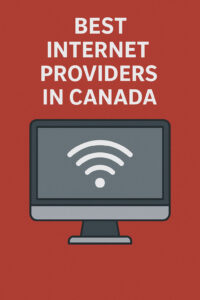For serious gamers in Canada, your internet connection is the most important piece of gear you own. It powers every clutch moment in VALORANT and every clean rotation in Warzone. Providers love to shout about multi-gigabit speeds, but veterans know the truth: a great gaming setup is built on stability, responsiveness, and consistently low latency. This guide cuts through the noise and focuses on what actually improves your win rate.
What Actually Matters For A Gaming Connection
Raw download speed is only part of the story. If you care about smooth aim, reliable hit-reg, and clean voice comms, prioritize the metrics below.
1. Latency (Ping)
What it is: Round-trip time between your device and the game server, measured in milliseconds.
In-game impact: Lower ping means your actions register faster. Under ~30 ms feels instant; above ~100 ms starts to hurt competitive play.
2. Stability (Jitter and Packet Loss)
What it is: Jitter is the swing in your ping over time. Packet loss is data that never arrives.
In-game impact: Spikes and loss cause rubber-banding, desync, and voice stutter even when your download speed looks fine.
3. Upload Speed and Symmetry
What it is: Upload is how fast you send data out. Symmetric plans give equal download and upload.
In-game impact: Cleaner voice chat, hosting lobbies, and streaming to Twitch or YouTube without dragging down your match.
4. NAT Type
What it is: Router translation mode that affects how easily your console or PC connects to others.
In-game impact: Open NAT helps with matchmaking and party chat. Strict NAT can block lobbies and voice.
- Use Ethernet for your PC or console.
- Enable UPnP in your router for NAT.
- Turn on QoS or SQM to tame bufferbloat.
Best Connection Types For Gaming In Canada
Your experience depends on the technology at your address. If you can choose fibre, do it. If not, an upgraded cable can be excellent, and modern fixed wireless is far better than old satellite.
Fiber To The Home: Top Choice For Competitive Play
Fiber uses light over glass, which naturally delivers low latency, rock-solid stability, and symmetric speeds. Ideal for sweaty ranked nights and streaming your matches at the same time.
Bell Fibe Internet
Why gamers like it: Extremely low and consistent ping with symmetric bandwidth for voice and streams.
Ontario and Quebec cores. Start with Toronto internet availability if you are in the GTA.
Gigabit tiers are overkill for raw gameplay, but symmetry helps when the household is busy.
Telus PureFibre
Why gamers like it: Western Canada fiber with strong reliability and smooth ping in team games.
BC and Alberta. Check availability around Vancouver internet and nearby cities.
2.5 Gbps tiers pair well with modern routers that support 2.5G Ethernet WAN/LAN.
Upgraded Cable: Strong Runner-Up With Wide Coverage
Modern cable networks upgraded with higher upstream splits can offer fiber-like bandwidth and very playable latency. It is a practical choice when fiber is not yet on your street.
Rogers Ignite
Why gamers like it: Broad availability with improving upload speeds in upgraded areas.
Large Ontario coverage including the GTA. See neighbourhood-level options on the Toronto internet page.
Latency is usually a touch higher than fiber, but stable wiring and a good modem keep it consistent.
Modern Fixed Wireless: Rural Gaming That Actually Works
If you are outside major builds, new 5G fixed wireless can deliver respectable latency and steady speeds. It is a massive upgrade over legacy satellite for online play.
Xplore 5G Home Internet
Why gamers like it: Brings low-enough ping for competitive shooters to towns and acreage properties that lack wired options.
Check line-of-sight to a nearby tower. If you move later, compare plans in larger hubs like Calgary internet.
Trees and terrain matter. A small outdoor antenna and proper alignment make a big difference.
Hardware And Setup: Half The Battle
Use Ethernet For Your Primary Device
A wired Cat6 cable from router to PC or console removes Wi-Fi interference, lowers ping, and eliminates random loss. It is the single biggest upgrade most players can make.
Choose A Router That Handles Traffic Gracefully
Look for Wi-Fi 6 or 6E, a fast CPU, and quality-of-service features. Routers with Smart Queue Management prevent bufferbloat when someone starts a big download mid-match.
Fix Strict NAT Without Headaches
Enable UPnP first. If that fails, manually forward ports suggested by your game or platform. Avoid double-NAT by using bridge mode if your ISP provides a gateway plus your own router.
FAQ
Is gigabit necessary for gaming?
Not for the game itself. Most titles use very little bandwidth. Gigabit helps keep latency stable when others in the home stream 4K or download updates while you play.
What is a good ping for competitive shooters?
Under ~30 ms feels snappy, 30–60 ms is very playable, and above ~100 ms you will notice delayed peeks and trades.
How do I reduce jitter and packet loss?
Use Ethernet, update your modem and router firmware, enable SQM, and replace damaged coax or Ethernet runs. Avoid powerline for competitive play.
Can a “gaming VPN” lower ping?
Sometimes. These services may route traffic more directly to a game server. They help most when your ISP’s default path is congested, not when your local connection is the bottleneck.
Bottom Line
If fiber is at your address, it is the winner for competitive play. If not, an upgraded cable plan can be excellent, and modern fixed wireless is finally viable for rural gamers. Wire your main device, enable QoS or SQM, and keep NAT open. Do those basics right and your shot timing and team comms will feel instantly better.






